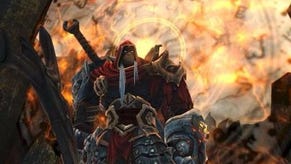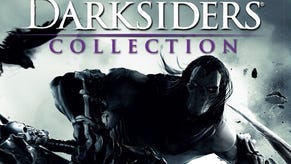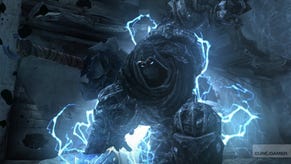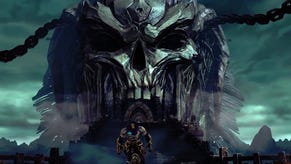Darksiders: Wrath of War
Apocalypse neigh.
Well, it's the apocalypse again, but at least Darksiders: Wrath of War has the class to bring in the big guns. This time we get the Four Horsemen themselves, War, Death, Strife and Fury. The eagle-eyed among you may have noticed that the last two are new additions from the subs bench; that's presumably because it's hard to make Famine and Pestilence look cool. But if you think the set-up promises biblical four-player co-op, you can forget it. This is a one-horseman show, with War taking centre-stage, and the others, according to developer Vigil, relegated to NPC roles.
It seems that War's been tricked into triggering the apocalypse early, which is all a bit embarrassing. Now, in true Metroid style, our horse-loving antihero has been stripped of his powers, and returned to the charred remains of Earth to investigate what went wrong. (Presumably, these orders came from the little-known Fifth Horseman, Social Accountability.) That's pretty much it for the story, and despite all the talk of demonic councils and a quest for revenge, the narrative's purely there to justify a trawl around the game-world, periodically reacquiring old powers and opening up more of the map. This is hardly a disappointment, since playing a game like Darksiders for the plot is a bit like buying a newspaper to make an origami hat out of it: some people may choose to do it, but they're probably missing the point.
And the real point of Darksiders is the combat and puzzles. On your horse, charmingly named Ruin, you ride about a large overworld exploring, battling monsters, and fulfilling the odd side-quest. It's a bit like Zelda, except it's post-apocalyptic and generally rather gothic, and you can chuck burnt-out cars at enemies and cut off their arms and watch blood spurt out before you head off to tackle a giant burrowing worm that's just erupted nearby.

In between this, you battle your way, room by room, through a series of dungeons, finding useful items that will prove strangely perfect when fighting the bosses. Again, it's a bit like Zelda, except it's post-apocalyptic and definitely highly gothic this time, given that the dungeon we recently got the chance to play through is also an abandoned church, with bat creatures flapping about and skeletons ready to do you wrong. In fact, if it were any more gothic, the dungeon's boss would be a fifteen-year-old girl with complicated clothing accessories who attacks by scribbling bad, home-made song lyrics on you in green biro. (It's not, though - it's actually a giant bat-dragon.)
As you may have gathered by now, Darksiders is a little bit like Zelda. You could argue that it's simply channelling twenty years of dungeon-based RPG traditions, but you have to understand how unmistakably Hyrulian some of the elements it offers up are. Naturally, there are standards like left-trigger targeting and that particular brand of overworld-to-dungeon-to-overworld pacing - these are things a thousand games have used, and the mechanics have become industry stalwarts on a par with Halo's rechargeable shield. But Darksiders goes further, taking entire concepts wholesale, and using them in pretty much identical ways. There are bomb plants, for example, which are yanked from the ground and hurled at barriers before they explode. Then there's a boomerang - the special weapon from the dungeon we played - that locks onto multiple targets and can even be used to carry fire from torches to a different point on the map.

Darksiders is hardly the first game to lift things from Zelda. It's a treasure chest that many titles have dipped into - even a few critical favourites like Beyond Good & Evil. Equally, in return, recent Zelda games have been eager to pinch a few things themselves, notably Twilight Princess's occasional looting of Shadow of the Colossus. But the extent here might give you pause: from level design to enemy types, there's a myriad tiny details in Darksiders that suggest the next time Link gets home to his pixie mansion, he may find the window jimmied open and his belongings scattered about.
Happily, however, when we got deeper into the dungeon, we also discovered that Darksiders is a little bit like God of War and Devil May Cry, too, with a far more elaborate, and crunchingly satisfying move-set than Link's. Although it never approaches the complexities of Dante's or Kratos's combat, there's still a wide variety of possible choices, with a ground-pounding area attack, numerous swordplay options, airborne combat where you can swing between hovering bats, hacking them to pieces as you go, and the inclusion of a variety of guns, manufactured by both demons and angels (this raises some theological questions), which we saw but didn't get to play with.
















